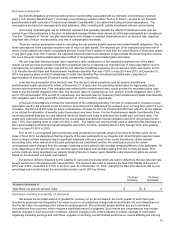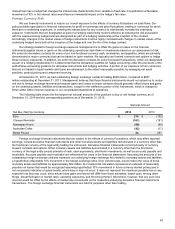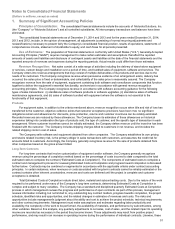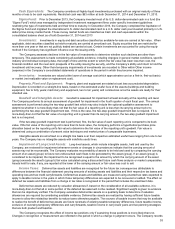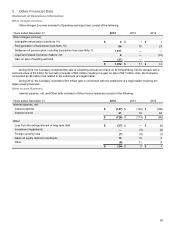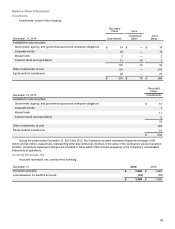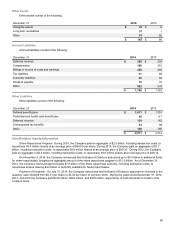Motorola 2014 Annual Report Download - page 53
Download and view the complete annual report
Please find page 53 of the 2014 Motorola annual report below. You can navigate through the pages in the report by either clicking on the pages listed below, or by using the keyword search tool below to find specific information within the annual report.51
Notes to Consolidated Financial Statements
(Dollars in millions, except as noted)
1. Summary of Significant Accounting Policies
Principles of Consolidation: The consolidated financial statements include the accounts of Motorola Solutions, Inc.
(the “Company” or “Motorola Solutions”) and all controlled subsidiaries. All intercompany transactions and balances have been
eliminated.
The consolidated financial statements as of December 31, 2014 and 2013 and for the years ended December 31, 2014,
2013 and 2012, include, in the opinion of management, all adjustments (consisting of normal recurring adjustments and
reclassifications) necessary to present fairly the Company's consolidated financial position, results of operations, statements of
comprehensive income, statement of stockholder's equity, and cash flows for all periods presented.
Use of Estimates: The preparation of financial statements in conformity with United States ("U.S.") Generally Accepted
Accounting Principles ("GAAP") requires management to make certain estimates and assumptions that affect the reported
amounts of assets and liabilities and disclosure of contingent assets and liabilities at the date of the financial statements and the
reported amounts of revenues and expenses during the reporting periods. Actual results could differ from those estimates.
Revenue Recognition: Net sales consist of a wide range of activities including the delivery of stand-alone equipment
or services, custom design and installation over a period of time, and bundled sales of equipment, software and services. The
Company enters into revenue arrangements that may consist of multiple deliverables of its products and services due to the
needs of its customers. The Company recognizes revenue when persuasive evidence of an arrangement exists, delivery has
occurred, the sales price is fixed or determinable, and collectability of the sales price is reasonably assured. The Company
recognizes revenue from the sale of equipment, equipment containing both software and nonsoftware components that function
together to deliver the equipment’s essential functionality, and services in accordance with general revenue recognition
accounting principles. The Company recognizes revenue in accordance with software accounting guidance for the following
types of sales transactions: (i) standalone sales of software products or software upgrades, (ii) standalone sales of software
maintenance agreements, and (iii) sales of software bundled with equipment where the software is not essential to the
functionality of that equipment.
Products
For equipment sales, in addition to the criteria mentioned above, revenue recognition occurs when title and risk of loss has
transferred to the customer, objective evidence exists that customer acceptance provisions have been met, no significant
obligations remain and allowances for discounts, price protection, returns and customer incentives can be reliably estimated.
Recorded revenues are reduced by these allowances. The Company bases its estimates of these allowances on historical
experience taking into consideration the type of products sold, the type of customer, and the specific type of transaction in each
arrangement. Where customer incentives cannot be reliably estimated, the Company defers revenue until the incentive has been
finalized with the customer. The Company includes shipping charges billed to customers in net revenue, and includes the
related shipping costs in cost of sales.
The Company sells software and equipment obtained from other companies. The Company establishes its own pricing
and retains related inventory risk, is the primary obligor in sales transactions with customers, and assumes the credit risk for
amounts billed to customers. Accordingly, the Company generally recognizes revenue for the sale of products obtained from
other companies based on the gross amount billed.
Long-Term Contracts
For long-term contracts that involve customization of equipment and/or software, the Company generally recognizes
revenue using the percentage of completion method based on the percentage of costs incurred to date compared to the total
estimated costs to complete the contract (“Estimated Costs at Completion”). The components of estimated costs to complete a
contract and management’s process for reviewing Estimated Costs at Completion and progress toward completion is discussed
further below. Contracts may be combined or segmented in accordance with the applicable criteria under contract accounting
principles. In certain instances, when revenues or costs associated with long-term contracts cannot be reliably estimated or the
contract contains other inherent uncertainties, revenues and costs are deferred until the project is complete and customer
acceptance is obtained.
Total Estimated Costs at Completion include direct labor, material and subcontracting costs. Due to the nature of the work
required to be performed under many of the Company’s long-term contracts, determining Estimated Costs at Completion is
complex and subject to many variables. The Company has a standard and disciplined quarterly Estimated Costs at Completion
process in which management reviews the progress and performance of open contracts. As part of this process, management
reviews information including, but not limited to, any outstanding key contract matters, progress towards completion, the project
schedule, identified risks and opportunities, and the related changes in estimates of revenues and costs. The risks and
opportunities include management's judgment about the ability and cost to achieve the project schedule, technical requirements,
and other contract requirements. Management must make assumptions and estimates regarding labor productivity and
availability, the complexity of the work to be performed, the availability of materials, and performance by subcontractors, among
other variables. Based on this analysis, any quarterly adjustments to net sales, cost of sales, and the related impact to operating
income are recorded as necessary in the period they become known. These adjustments may result from positive project
performance, and may result in an increase in operating income during the performance of individual contracts. Likewise, these


